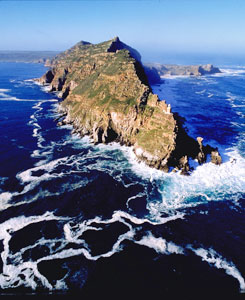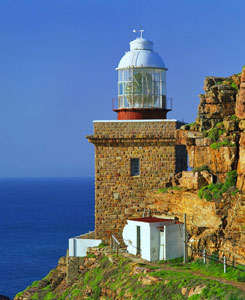Cape Point, Cape Town
At the end of the Cape Peninsula, about 80 km from Cape Town, is Cape Point. Also known as the Cape of Good Hope or Cape of Storms it lies within the Good Hope portion of the Table Mountain National Park, a World Heritage Site.
This wind-battered, tip of land that ventures out into treacherous seas has some of the highest sea cliffs and freshest air in the world. It is not the southern most tip of Africa. This honour has been left to Cape Agulhas. However it is a far more frequently visited and impressive attraction.
The indigenous flora here is found nowhere else on earth and it is home to a variety of animals including buck, Chacma baboons, Cape Mountain Zebra and over 250 species of bird.


The original discovery of the Cape by Dias and subsequently da Gama opened up the Cape sea route allowing trade between East and West but placed thousands of sailors’ lives at stake in the process. The lighthouse originally built on Cape Point Peak in 1857 was invisible to ships at sea from a certain angle, resulting in the litter of shipwrecks that mark this rocky coastline.
Today the lighthouse is the most powerful on the South African coast and has been moved to stand above Cape Point. The Flying Dutchman funicular takes passengers 238 metres above sea level to the old lighthouse on a rather invigorating ride and the Shipwreck trail is a coastal hike that starts at Olifantsbos on the western side of the reserve.
There are a number of marked paths for strolls or longer walks within the Cape reserve. The Smitswinkel viewpoint is 15 minute walk through unique fynbos whilst the Cape of Good Hope trail is a two-day event.
There are a couple of safe tidal pools at Bordjiesdrif and Buffels Bay for swimming and visitors are welcome to braai and picnic at designated spots. The Buffelsfontein visitors centre has a number of displays and presentations about the area and there is a restaurant perched above the booming waves with superb views.
Interestingly the South African Weather Bureau maintains a research laboratory here together with the Fraunhofer Institute of Garmisch, Germany. They monitor long-term changes in the earth’s atmosphere which may impact upon climate.
To view additional information about Cape Point, visit: Cape Point.
Related Links
- Holiday Accommodation Nearby
VIEW Cape Point, Castle Rock, Clovelly, Fish Hoek, Glencairn, Kalk Bay, Kommetjie, Muizenberg, Noordhoek, Scarborough, Simons Town, St James
















